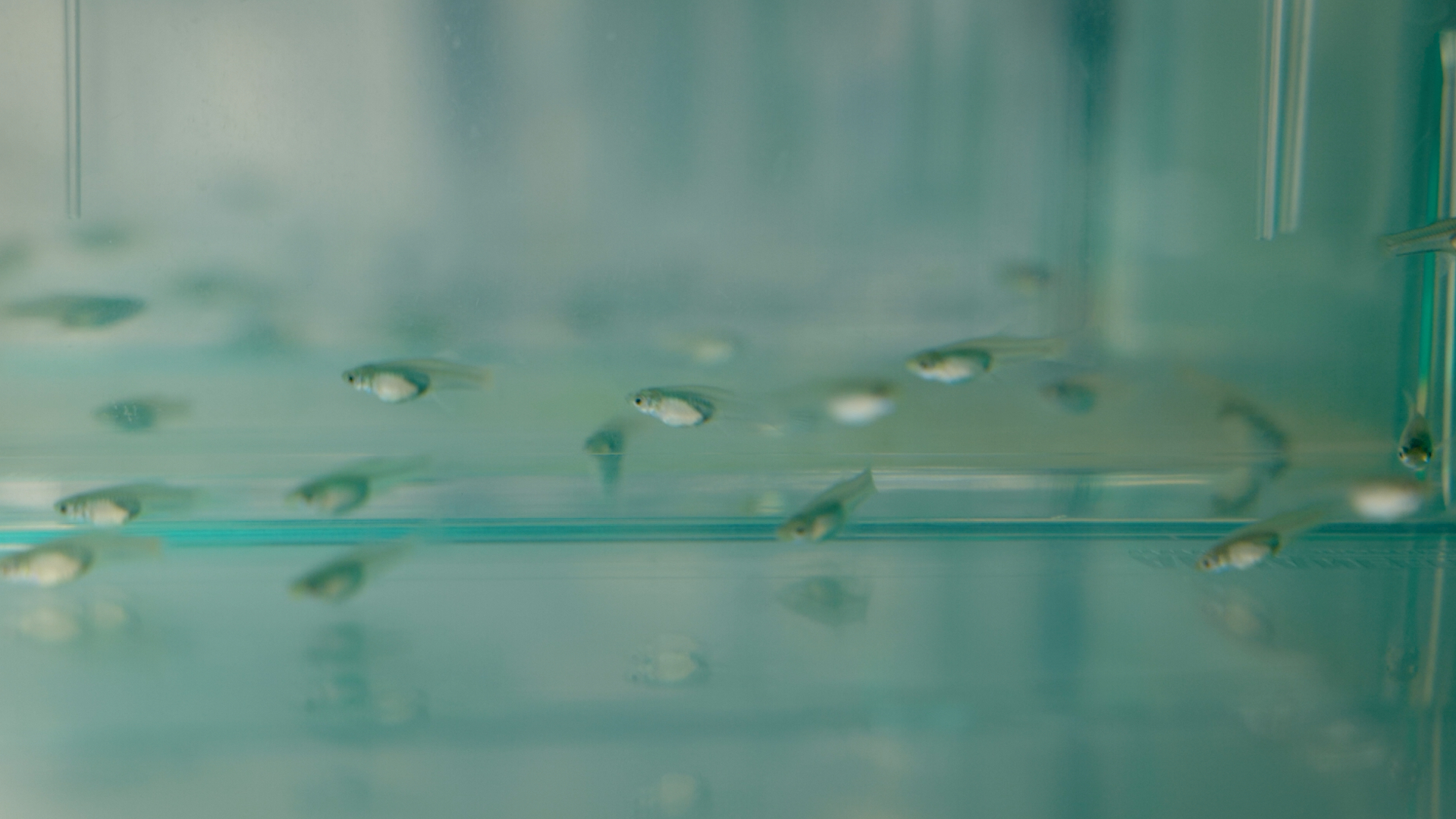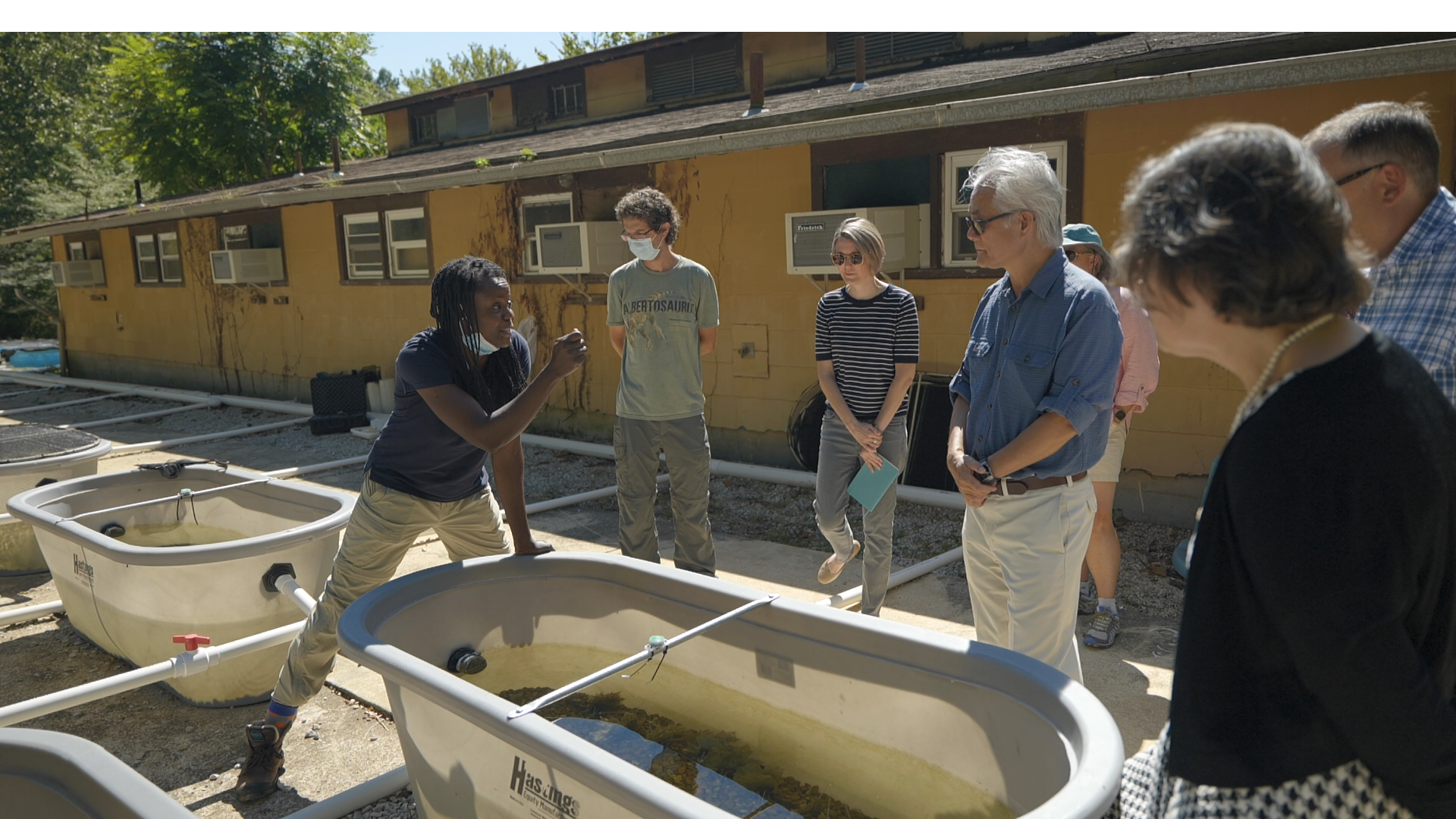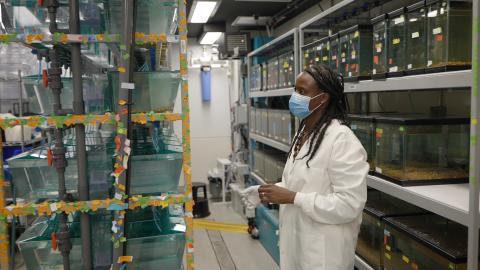Female guppies eat differently when they have to contend with sneaky male suitors, according to ongoing research from biologist Swanne Gordon in Arts & Sciences. Her work is starting to show how behavior can have a ripple effect on the environment in new places where guppies have been introduced. Mating strategy and other behaviors have been largely overlooked in the study of ‘eco-evo’ dynamics until now.
“Guppies are massive invaders,” said Swanne Gordon, assistant professor of biology in Arts & Sciences at Washington University in St. Louis.

Gordon herself is surrounded by an army of them. Dozens of the tiny, silvery fishes fill an array of fish tanks that Gordon has carefully plumbed to imitate a stream system in the wild. Each tank is like a small pool in a continuous stream, connected by the same flowing water but separated from other pools (tanks) by small barrier waterfalls (tank walls).
At least that’s the dynamic Gordon set out to create, with her mind’s eye on the guppy’s native habitat in Trinidad – the lush Caribbean island where Gordon began studying guppies as a model organism for rapid evolution, back in her graduate student days.
Now Gordon has her own mock streams set up in a basement-level laboratory on the Danforth Campus and also, seasonally, in a more convincing outdoor setting at Tyson Research Center, Washington University’s environmental field station.
“Guppies have an important kind of connection with the environment, such that when you introduce them into new places, they rapidly adapt to any particular changes that they might find there,” Gordon said.
While some research has shown how introduced animals go on to change the new worlds they find themselves in, little is known about the role of behavior and sexual selection in this two-way street.
Gordon is setting out to address this gap, starting with a series of experiments that examine how guppy mating behavior impacts their diet, which ultimately impacts their environment – among other things.
“Guppies are one of the few systems where people have been able to show eco-evo feedbacks, with both sides of the feedback loop,” Gordon said.
“Many systems can show that ecology can drive the evolution of traits,” she said. “But not many other systems can show that as organisms are adapted to certain environments, they can then exert changes on the environment itself.”
Little fish, big impact

Originally from tropical climates, guppies are now found on every continent except Antarctica. Humans brought guppies around the world as pets and for biological control of mosquitoes.
But as small as they are – adult Trinidadian guppies are only about half the length of Gordon’s fingers – they have an impact in the waters where they have been released.
Guppies have a very short generation time, which means that each introduced guppy can make a lot more guppies (100 to 200 days per generation is typical).
Female fish are bigger, live longer and are capable of storing sperm from the males they mate with. In fact, in one of Gordon’s previous studies, scientists found that 25 percent of guppies were born of “zombie” fathers – their dads were dead by the time the babies hatched.
Male guppies have a few tricks up their sleeves, too.
They use two different mating strategies. In one, males perform a kind of courtship dance, bending their bodies into an s-shape and shaking the bright orange tips of their fins at females. In the other strategy – what Gordon calls “sneak” mating behavior – males harass females instead of courting them, relying on surprise and force to mate.
“We know that these sexual behaviors have a genetic basis, and that they are differentiated in guppies from different environments,” she said. “So, guppies that live or coexist with predators in a high-predation environment will typically use a sneak pattern or a sneaky behavior. And guppies that are in low predation environments will generally use this courtship display to show their coloration.”
Gordon is particularly focused on uncovering the role of behavior in evolutionary dynamics. With her new work at Tyson Research Center, she is beginning to show some interesting ways that evolutionarily driven behavioral changes can have a ripple effect.
“Research from my group and others has shown rapid evolution in life history traits and also rapid evolution in coloration when guppies are moved from high predation areas to new environments where there are no predators,” she said.
“It can happen in as little as three generations, which is extremely fast.”

One of the changes that Gordon and her co-principal investigator Andrés Lopez-Sepulcre, postdoctoral research associate Yusan Yang, and the rest of their team explored last summer relates to how sexual behaviors affect how much, and potentially what, female guppies are eating. Preliminary results suggest that female guppies really do eat differently when they have to contend with harassing male suitors.
But put guppies in a place where they have no predators, and male harassment abates. Females can finally relax, and this affects how much, and potentially what, they choose to eat.
Guppy food choices have an impact on the environment, because – whether it’s algae, decomposing leaves or small aquatic insects – what female guppies are eating matters for other animals that eat the same kind of things.
Rapid evolution in a changing world
Understanding how guppies and other species adapt – and how they themselves then alter the environment around them – is increasingly important in our interconnected world.
“Our world is changing,” Gordon said. “When changes happen, they may be abrupt, they may be extreme, or they may be transitional over time. But what are the characteristics that allow organisms to survive and adapt to these changes?”
She envisions a future network of other artificial stream systems set up to study guppies under other conditions in other parts of the world.
“Now that we have found that guppies have a major role in affecting ecosystem structure and function, my big idea is to group together a team of scientists who want to study the global effect of guppies in different places – and their effects on different types of environments,” Gordon said.
“It’s a hefty goal, but it’s one that’s quite important for us to be able to really extrapolate the effect of guppies on the environment, and how big of a footprint they might have.”





